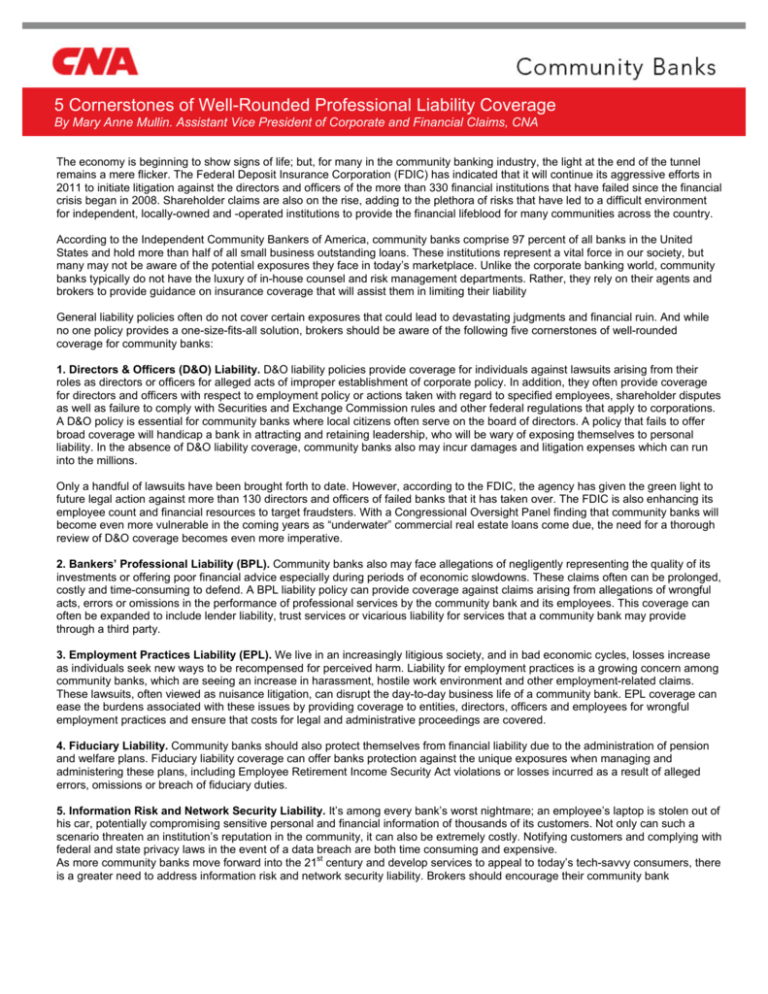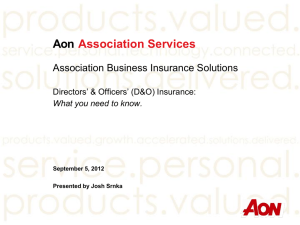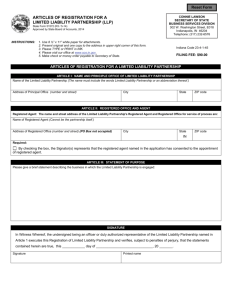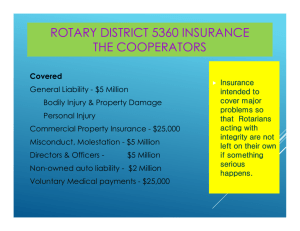
5 Cornerstones of Well-Rounded Professional Liability Coverage
By Mary Anne Mullin. Assistant Vice President of Corporate and Financial Claims, CNA
The economy is beginning to show signs of life; but, for many in the community banking industry, the light at the end of the tunnel
remains a mere flicker. The Federal Deposit Insurance Corporation (FDIC) has indicated that it will continue its aggressive efforts in
2011 to initiate litigation against the directors and officers of the more than 330 financial institutions that have failed since the financial
crisis began in 2008. Shareholder claims are also on the rise, adding to the plethora of risks that have led to a difficult environment
for independent, locally-owned and -operated institutions to provide the financial lifeblood for many communities across the country.
According to the Independent Community Bankers of America, community banks comprise 97 percent of all banks in the United
States and hold more than half of all small business outstanding loans. These institutions represent a vital force in our society, but
many may not be aware of the potential exposures they face in today’s marketplace. Unlike the corporate banking world, community
banks typically do not have the luxury of in-house counsel and risk management departments. Rather, they rely on their agents and
brokers to provide guidance on insurance coverage that will assist them in limiting their liability
General liability policies often do not cover certain exposures that could lead to devastating judgments and financial ruin. And while
no one policy provides a one-size-fits-all solution, brokers should be aware of the following five cornerstones of well-rounded
coverage for community banks:
1. Directors & Officers (D&O) Liability. D&O liability policies provide coverage for individuals against lawsuits arising from their
roles as directors or officers for alleged acts of improper establishment of corporate policy. In addition, they often provide coverage
for directors and officers with respect to employment policy or actions taken with regard to specified employees, shareholder disputes
as well as failure to comply with Securities and Exchange Commission rules and other federal regulations that apply to corporations.
A D&O policy is essential for community banks where local citizens often serve on the board of directors. A policy that fails to offer
broad coverage will handicap a bank in attracting and retaining leadership, who will be wary of exposing themselves to personal
liability. In the absence of D&O liability coverage, community banks also may incur damages and litigation expenses which can run
into the millions.
Only a handful of lawsuits have been brought forth to date. However, according to the FDIC, the agency has given the green light to
future legal action against more than 130 directors and officers of failed banks that it has taken over. The FDIC is also enhancing its
employee count and financial resources to target fraudsters. With a Congressional Oversight Panel finding that community banks will
become even more vulnerable in the coming years as “underwater” commercial real estate loans come due, the need for a thorough
review of D&O coverage becomes even more imperative.
2. Bankers’ Professional Liability (BPL). Community banks also may face allegations of negligently representing the quality of its
investments or offering poor financial advice especially during periods of economic slowdowns. These claims often can be prolonged,
costly and time-consuming to defend. A BPL liability policy can provide coverage against claims arising from allegations of wrongful
acts, errors or omissions in the performance of professional services by the community bank and its employees. This coverage can
often be expanded to include lender liability, trust services or vicarious liability for services that a community bank may provide
through a third party.
3. Employment Practices Liability (EPL). We live in an increasingly litigious society, and in bad economic cycles, losses increase
as individuals seek new ways to be recompensed for perceived harm. Liability for employment practices is a growing concern among
community banks, which are seeing an increase in harassment, hostile work environment and other employment-related claims.
These lawsuits, often viewed as nuisance litigation, can disrupt the day-to-day business life of a community bank. EPL coverage can
ease the burdens associated with these issues by providing coverage to entities, directors, officers and employees for wrongful
employment practices and ensure that costs for legal and administrative proceedings are covered.
4. Fiduciary Liability. Community banks should also protect themselves from financial liability due to the administration of pension
and welfare plans. Fiduciary liability coverage can offer banks protection against the unique exposures when managing and
administering these plans, including Employee Retirement Income Security Act violations or losses incurred as a result of alleged
errors, omissions or breach of fiduciary duties.
5. Information Risk and Network Security Liability. It’s among every bank’s worst nightmare; an employee’s laptop is stolen out of
his car, potentially compromising sensitive personal and financial information of thousands of its customers. Not only can such a
scenario threaten an institution’s reputation in the community, it can also be extremely costly. Notifying customers and complying with
federal and state privacy laws in the event of a data breach are both time consuming and expensive.
As more community banks move forward into the 21st century and develop services to appeal to today’s tech-savvy consumers, there
is a greater need to address information risk and network security liability. Brokers should encourage their community bank
customers to consider coverage that will address breach of data by outsiders and employees, the theft or loss of removable media
such as laptops and PDAs, and injury resulting from the unauthorized use or disclosure of private information in the bank’s custody.
Working with your community banking customers to review or round out their coverage will provide a sound insurance program
during these challenging times and allow these institutions to focus on what matters most – driving small business growth and
keeping local communities vibrant for years to come.
4 Things to Keep in Mind When Evaluating Coverage
When evaluating coverage for your community banking clients, it is important to keep the following in mind:
1.
Know who is covered. Make sure all directors and officers – appointed or elected – are covered under the community
bank’s D&O policy. In addition, all employees should be covered under an EPL policy. Banks also must consider whether or
not independent contractors or temporary workers should be included in the coverage.
2.
Understand how policies are triggered. Unlike general liability coverage, professional liability policies are “claims-made,”
meaning that they are triggered when a lawsuit or written demand for monetary relief is filed, as opposed to when an act
occurred. Brokers must be aware of this critical distinction and be able to explain it to their community banking customers.
3.
Be familiar with an insurer’s claim reputation. An insurer’s ability to effectively and efficiently handle claims is critical.
Does the company have community banking experience, and is it willing to meet directly with the insureds prior to a claim,
renewal or inception of a policy? Will the company work closely with underwriters to ensure that both parties understand the
interpretation of the policy language? Consistent and seamless 24/7 support can go a long way in ensuring the best possible
outcome for your customers.
4.
Conduct a thorough review in conjunction with other policies. Professional liability policies for community banks have
become increasingly complex in recent years. It is important for brokers to not only educate themselves about these
coverages, but also conduct a thorough review of these policies in conjunction with a bank’s other coverages –
property/casualty, general liability, etc. – to identify any gaps that may leave the door open to potential risks.
About The Author
Mary Anne Mullin is Assistant Vice President of Corporate and Financial Claim for CNA Insurance Companies in New York, N.Y.
CNA is one of the nation’s leading commercial insurance providers and a proud member of the Independent Community Bankers of
America, supporting the business insurance needs of community banks for over 25 years.
For additional information on CNA’s Community Banks Program, please contact
Mark Tomlinson, Underwriting Director, at mark.tomlinson@cna.com or 312-822-4831.
The purpose of this article is to provide information, rather than advice or opinion. It is accurate to the best of the author’s knowledge as the date of presentation of the
article. Accordingly, this presentation should not be viewed as a substitute for the guidance and recommendations of a retained professional. In addition, CNA does not
endorse any coverages, systems, processes or protocols addressed herein unless they are produced or created by CNA.
Any references to non-CNA Websites are provided solely for convenience, and CNA disclaims any responsibility with respect to such Web sites.
To the extent that this article contains any examples, please note that they are for illustrative purposes only and any similarity to actual individuals, entities, places or
situations is unintentional and purely coincidental. In addition, any examples are not intended to establish any standards of care, to serve as legal advice appropriate for
any particular factual situations, or to provide an acknowledgement that any given factual situation is covered under any CNA insurance policy. Please remember that only
the relevant insurance policy can provide the actual terms, coverages, amounts, conditions and exclusions for an insured, All CNA products and services many not be
available in all states and may be subject to change without notice.
CNA is a registered trademark of CNA Financial Corporation. Copyright © 2011 CNA. All rights reserved.









